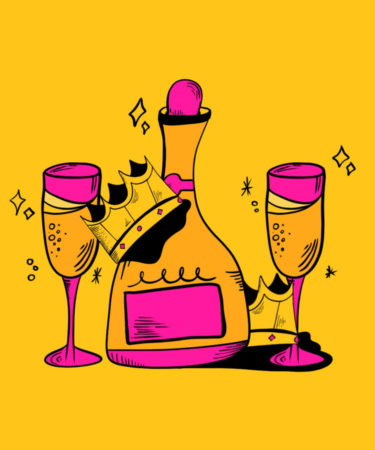Irish poet, playwright, and novelist Oscar Wilde believed that “only the unimaginative can fail to find a reason for drinking Champagne.” For most of us, however, exploding corks and flutes of fizzing French bubbles accompany only the most special occasions.
When selecting bottles to celebrate with, it’s common to query which is the best or most suitable Champagne, yet rarely do we consider why Champagne at all — despite so many other interesting and delicious styles of wine and alcohol.
The answer to this question, and the tale of how Champagne became the belle of the ball, is one of religion, royalty, European aristocracy, and — like most things relating to the history of French wine — calculated marketing.
Before the abolition of the French monarchy, France’s royal family had longstanding ties to the Champagne region. The multi-century connection began in 496, when reigning monarch Clovis I was baptized in a small church in Reims. The city and that exact spot (which was eventually replaced by a grand cathedral) went on to become the traditional location for French coronations, and cemented the link between region and royalty.
“Coronations inevitably involved celebrations, but until Charles III was crowned in 1575, wine from Burgundy had been preferred to the local product,” Nicholas Faith writes in “The Story of Champagne,” published in 1988. The local wines scarcely resembled modern-day Champagne. Charles III’s coronation predated the discovery of secondary fermentation, the method by which Champagne gains its bubbles, by almost a century, and it took another half-century of royal influence for the (sparkling) Champagne industry to gain any real traction.
In 1728, noted Champagne aficionado and 18th-century influencer King Louis XV decreed that only the wines of Champagne could be shipped in glass bottles. The order was significant for the region because it meant that if wealthy aristocrats wanted to emulate their fashionable monarch and drink highly effervescent bottled wines, they would have to buy them from Champagne.
Another notable tastemaker of the time who also had a famed thirst for Champagne was Madame de Pompadour, the mistress, friend, and advisor of Louis XV. Like her king, de Pompadour hosted grand parties where Champagne flowed in excess. During one notable masked ball, her guests consumed an incredible 1,800 bottles of Champagne. With the wealthy aristocracy of various European nations in regular attendance at these events, soon enough, an international demand for the sparkling wines of Champagne followed.
“Champagne became the most sought-after libation of celebration for the elite in the capitals of the Western world as the 18th century moved forward,” Becky Sue Epstein writes in “Champagne: A Global History,” published in 2011.
While it would always be synonymous with celebration, the sparkling wine’s availability only to the “elite” soon changed. In 1796, four years after the abolition of the French monarchy, the first president of the anti-monarchist United States, George Washington, served Champagne at a state dinner. The moment was a significant historical marker that Champagne was “no longer just for the titled aristocracy,” according to Epstein.
Within a century, one didn’t even have to hold office to toast with Champagne. In the latter half of the 1800s, increasing supply and better worldwide distribution channels made Champagne a commodity most middle-class families could afford. According to Kolleen Guy, author of “When Champagne Became French,” during France’s Belle Époque era (1871 to 1914), “turning points in life were celebrated by the opening of a bottle of Champagne, marking the event as above the mundane.”
The period also saw significant marketing efforts from Champagne houses to place their bubbles as the celebratory beverage. The images and language on many bottle labels targeted newly engaged couples and soon-to-be parents, while “newspaper advertisements, particularly around holidays like Christmas and New Year associated family gatherings with Champagne,” Guy writes.
Capturing the zeitgeist and perhaps the moment Champagne became synonymous with celebration, Guy also writes of one “observer” who, in 1881, noted that “the increased use of Champagne at festive gatherings was ‘a charming fashion that is beginning to be more common.’”
If modern-day graduations, weddings, baby showers, and New Year’s Eve festivities are anything to go by, the “charming fashion” is as strong today as it was over 100 years ago.
